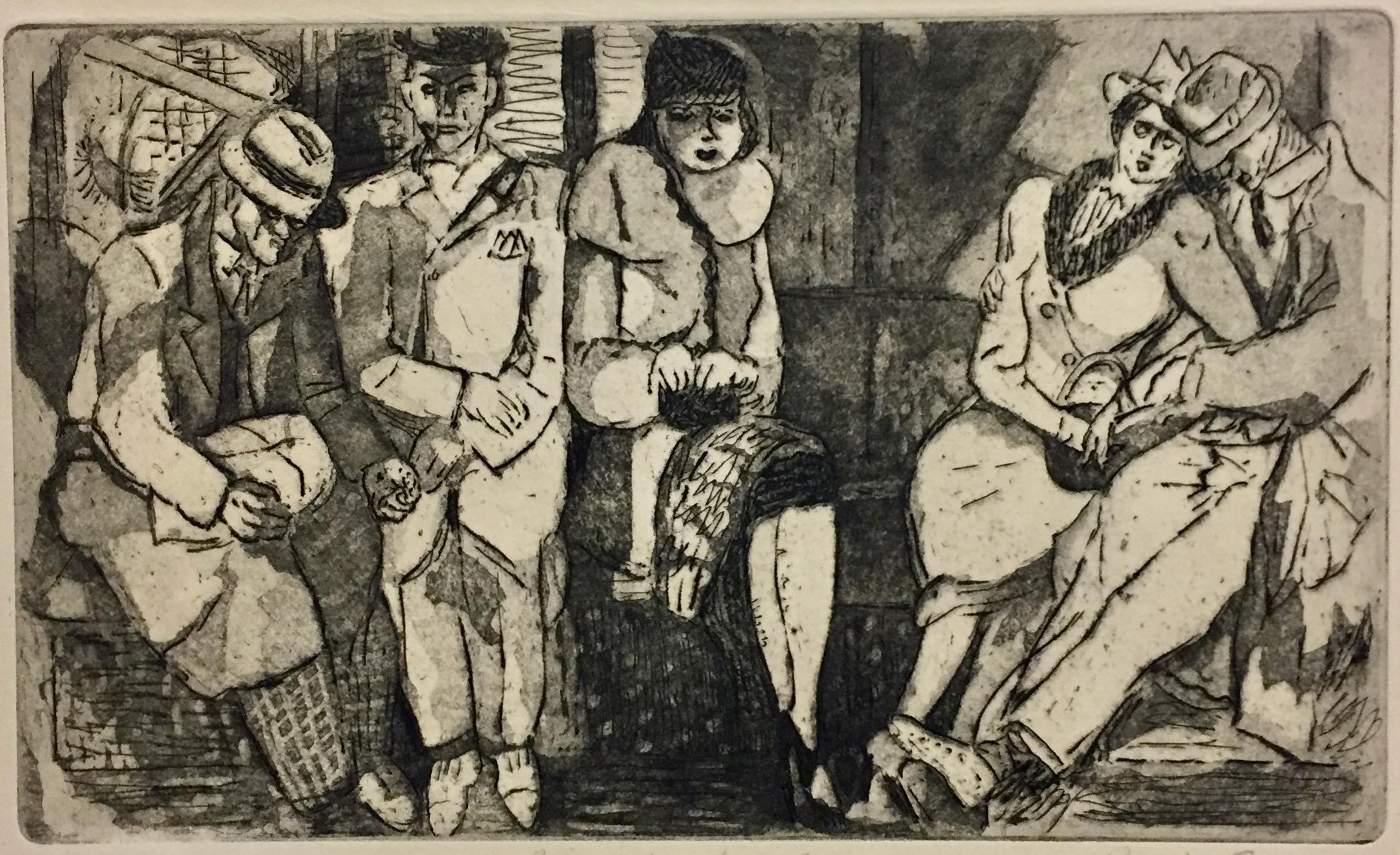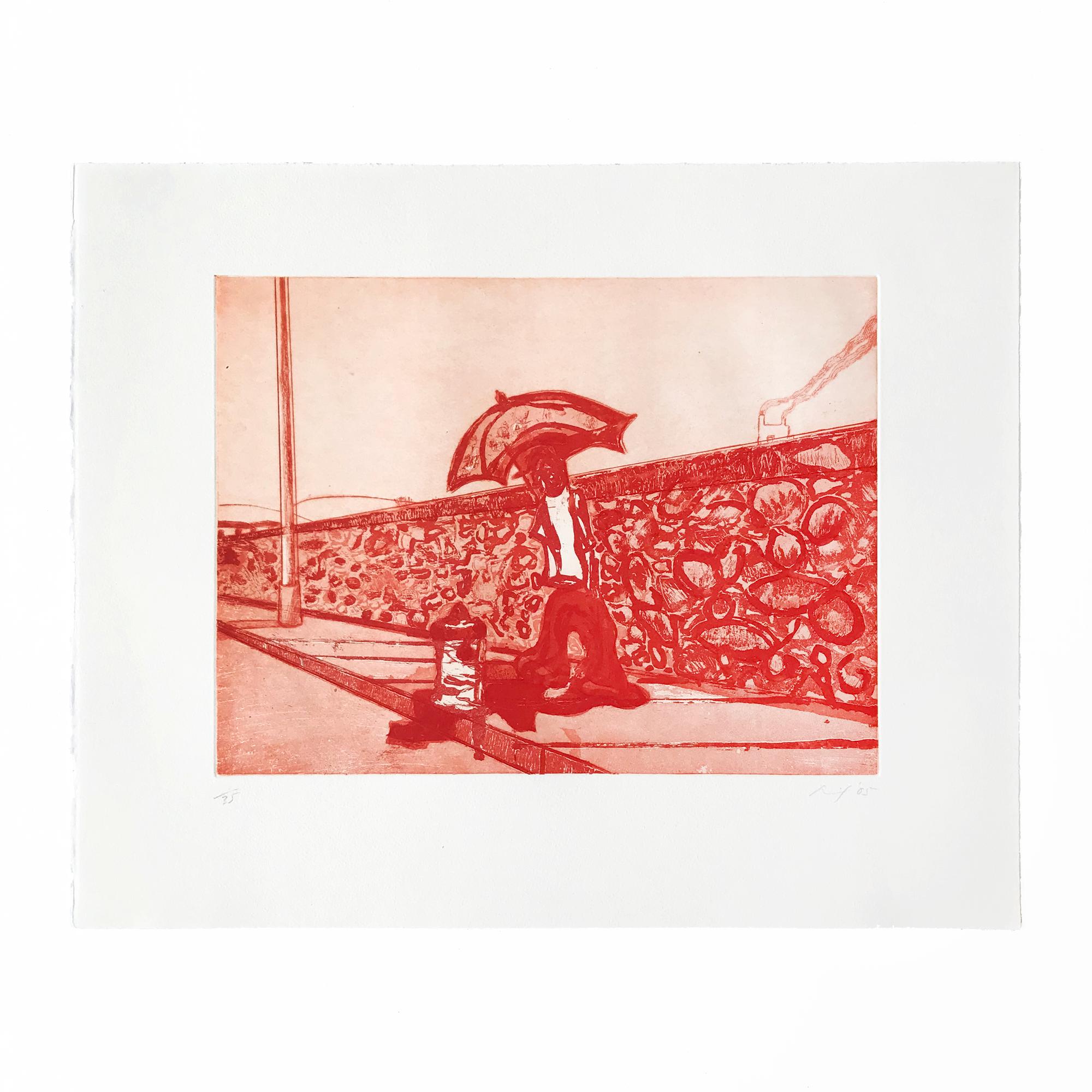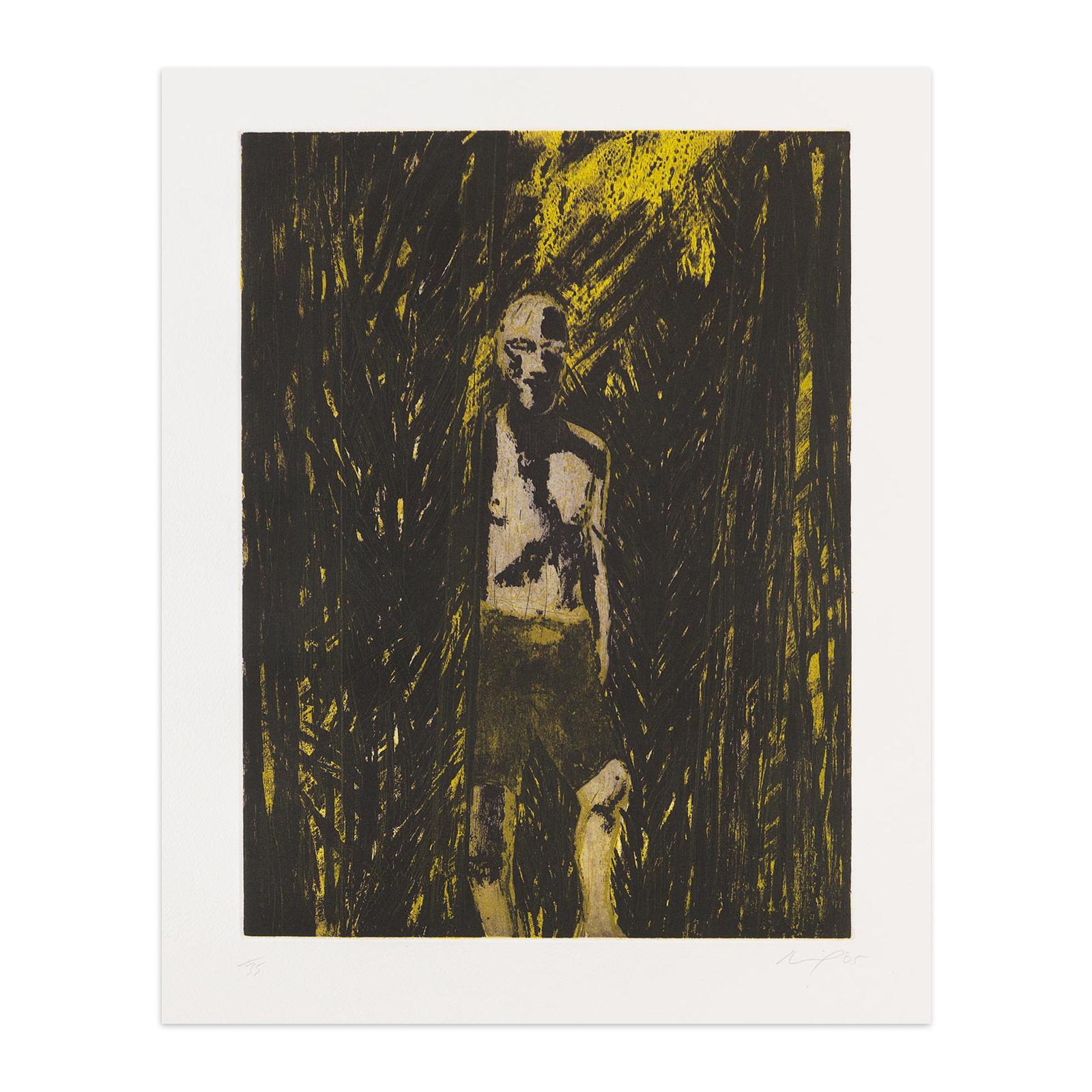Items Similar to Bow Street Office: Rowlandson Hand-colored Engraving from Microcosm of London
Want more images or videos?
Request additional images or videos from the seller
1 of 10
Thomas RowlandsonBow Street Office: Rowlandson Hand-colored Engraving from Microcosm of London 1808
1808
About the Item
An early 19th century print entitled "Bow Street Office", an illustration (Plate 11) from "The Microcosm of London", published in London in 1808 by R. Ackermann's Repository of Arts. The scene was created by one of the most famous British satirists and caricaturists of the late 18th and early 19th centuries' Georgian Period, Thomas Rowlandson, who drew the figures, while Augustus Charles Pugin drew the architecture. The plate was then created by Hill, Stadler and Bluck using a combination of aquatint and etching and was then hand colored with watercolor. Scenes illustrated in "The Microcosm of London" gives an accurate and often comical view of everyday life in London during the Regency Period of the early 19th century. While Pugin’s excellent architectural drawings capture the size and shape of the exterior as well as the interior of London’s principal buildings, Thomas Rowlandson’s insightful and often whimsical and satirical view of the city's inhabitants depicts the color and vitality of the late Georgian society, both rich and poor alike.
The print is held in the collections of many museums, including the Metropolitan Museum of Art and the British Museum. It is presented here in a black wood frame with gold trim along its inner and outer margins with a pale mint green colored mat. There is a tiny tear at the edge of the left margin, but the print is otherwise in very good condition. There are small frame defects.
This print depicts a London magistrates' court, the "Bow Street Office", where the accused were brought before the magistrate to hear their cases and the testimony of witnesses. The room is filled with criminals, common folk, magistrates and their assistants and the Bow Street Runners, whose role it was to apprehend and capture criminals and bring them to the court. This print beautifully conveys the sense of what it was like to be in this noisy, crowded and somewhat chaotic room.
The work of the magistrates’ offices in the late 18th and early 19th centuries was crucial to the administration of justice in London. The magistrates dealt with London’s minor crimes (such as drunkenness, fighting and prostitution) in a brisk manner, dealing with offenders by way of fines and short periods of imprisonment. Thus the magistrates were able to leave the higher courts, such as the Old Bailey, to deal with only more serious cases of felony. The first magistrates’ office was opened in London’s Bow Street in the 1740s where Thomas De Veil heard cases from a room in his own home. The famous author and playwright Henry Fielding (1707-1754) became the second Bow Street magistrate in 1748 and was the . Fielding, who was a friend of William Hogarth, published several pamphlets about the state of public order and crime in the capital. When Fielding died in 1754 he was replaced by his half-brother John, known as the ‘blind beak of Bow Street’, who was famous for his legal thoroughness despite being blind since a teenager. It was at this time that London’s first professional detective force was also implemented, the famous ‘Bow Street Runners’ who travelled the country in pursuit of criminals.
- Creator:Thomas Rowlandson (1756 - 1827, British)
- Creation Year:1808
- Dimensions:Height: 18.5 in (46.99 cm)Width: 20 in (50.8 cm)Depth: 0.88 in (2.24 cm)
- Medium:
- Period:1800-1809
- Condition:
- Gallery Location:Alamo, CA
- Reference Number:
About the Seller
5.0
Platinum Seller
These expertly vetted sellers are 1stDibs' most experienced sellers and are rated highest by our customers.
Established in 2011
1stDibs seller since 2019
233 sales on 1stDibs
Typical response time: 1 hour
- ShippingRetrieving quote...Ships From: Alamo, CA
- Return PolicyA return for this item may be initiated within 7 days of delivery.
More From This SellerView All
- 18th Century Etching of Ancient Roman Architectural Objects by Giovanni PiranesiBy Giovanni Battista PiranesiLocated in Alamo, CAA. Tigna Protensa Super Media Epistylia, B. Praecisiones Tigorum Quaqua Versus Extrinsectus Apparentium, C. Opae Extremitates Tigorum Contintes, Fig. I, plate 88 from "Vasi, Candelab...Category
Mid-18th Century Old Masters Figurative Prints
MaterialsEtching
- Ancient Roman Medici Marble Vase: An 18th Century Etching by PiranesiBy Giovanni Battista PiranesiLocated in Alamo, CAThis large 18th century etching by Giovanni Battista Piranesi is entitled "Vaso antico di Marmo adornato di eccellenti Sculture si nella parte anteriere che nell' opposta, le quail r...Category
1770s Old Masters Figurative Prints
MaterialsEtching
- Ancient Roman Marble Vase: 18th C. Piranesi Etching Vaso Cinerario di Gran MoleBy Giovanni Battista PiranesiLocated in Alamo, CA"Vaso Cinerario di Gran Mole. Le Teste dei Giovenchi mostrano di reggere it pesante Festone composto di Frutti Fiori Grans ed use. Il tuto Necefsario all Vita Umana. Il Restante degl...Category
1760s Old Masters Figurative Prints
MaterialsEtching
- Church of St. Costanza, Rome: An 18th Century Piranesi Architectural EtchingBy Giovanni Battista PiranesiLocated in Alamo, CAThis is a framed 18th century Giovanni Battista Piranesi etching entitled: "Veduta interna del Sepocro di Santa Costanza, fabbricat...Category
1770s Old Masters Interior Prints
MaterialsEtching
- A Framed 18th C. Piranesi Etching of an Ancient Marble Vase from Hadrian's VillaBy Giovanni Battista PiranesiLocated in Alamo, CAThis large framed 18th century etching by Giovanni Battista Piranesi is entitled "Vaso antico di Marmo adornato di eccellenti Sculture si nella parte anteriere che nell' opposta, le ...Category
1770s Old Masters Figurative Prints
MaterialsEtching
- The Roman Colosseum: A Framed 18th Century Etching of the Interior by PiranesiBy Giovanni Battista PiranesiLocated in Alamo, CAThis large framed 18th century etching by Giovanni Battista Piranesi entitled "Veduta dell'interno dell'Anfiteatro Flavio detto il Colosseo" (View of the interior of the Flavian Amph...Category
1760s Old Masters Figurative Prints
MaterialsEtching
You May Also Like
- Room for One More (New York City Subway)By Irving GuyerLocated in New York, NYThis Depression-era New York City subway scene says it all. The body language of all five passengers tells us where each of them is in his or her ...Category
1930s Ashcan School Figurative Prints
MaterialsEtching, Aquatint
- Dornröschen (Sleeping Beauty.)By Heinrich VogelerLocated in Storrs, CTReif 20.IIc(of e). 10 5/8 x 9 3/4 (sheet 19 X 12 3/4). Slight scattered foxing in the margins, away from the image. A rich, tonal impression printed on sturdy wove paper. Proof aside...Category
Late 19th Century Jugendstil Figurative Prints
MaterialsFiberglass, Drypoint, Etching, Aquatint
- 'Evening Encounter', San Francisco Bay Area Modernist, Atelier 63 Woman ArtistBy Jane Voitle MellinLocated in Santa Cruz, CACreated circa 1975 and stamped, verso, with certification of authenticity for Jane Voitle Mellin (American, born 1952). Paper dimensions: 13.25 x 19.75 inches A atmospheric, sugar-...Category
1970s Surrealist Interior Prints
MaterialsPaper, Aquatint
- Peter Doig, Lapeyrouse Wall - Etching and Aquatint, British Art, Signed PrintBy Peter DoigLocated in Hamburg, DEPeter Doig (born 1959 in Edinburgh) Lapeyrouse Wall, 2005 Medium: Etching with aquatint printed in red on wove paper, with full margins Dimensions: 29.5 × 39.2 cm (45.4 x 56 cm) Edit...Category
21st Century and Contemporary Contemporary Figurative Prints
MaterialsEtching, Aquatint
- Scene Galante au XVIII eme Siecle #1By Antoine CalbetLocated in San Francisco, CAThis artwork titled "Scene Galante au XVIII eme Siecle" c.1930 in an aquatint on paper by French artist Antoine Calbet, 1860-1944. It is hand signed in pencil at the lower right corner. The plate mark (image) size is 9.60 x 12.25 inches, framed size is 16.5 x 19.5 inches. Framed in a wooden gold and black frame, with fabric matting. The artwork is in very good condition, frame and matting are in good condition, frame have some minor dents, matting have a small point of discoloration at upper left. About the artist. Antoine Calbet is the son of Marie Singlande and Jean-Baptiste Calbet, landowner at a place called Gaubert. Trained at the School of Fine Arts in Montpellier by Édouard - Antoine Marsal (1845-1929) where he learned drawing, this illustrator and illustrator, a painter of nudes and gallant scenes, was very popular during his lifetime. Antoine Calbet is then admitted to the School of Fine Arts in Paris in the studio of Alexandre Cabanel (1823-1889). He was a member of the admission jury of the Beaux-Arts from 1913 to 1930. He began to exhibit in 1880 and became a member of the Society of French Artists . He was the friend of his compatriot of Lot-et-Garonne, the President of the Republic Armand Fallières , for which he drew the menus of his meals, which made him known in Parisian salons.He illustrated works by Jean Lorrain , Henri de Regnier , Pierre Loues 3 and for periodicals like L'Illustration . Selected museums and collections Dallas , Dallas Museum of Art : Back woman...Category
Mid-20th Century Realist Figurative Prints
MaterialsAquatint
- Gauguin - Aquatint Etching by David BumbeckBy David BumbeckLocated in Long Island City, NYGauguin David Bumbeck, American (1940) Date: 1983 Etching, signed, numbered, dated, and titled in pencil Edition of 41/100 Image Size: 14.5 x 17.5 inches Size: 19 x 22 in. (48.26 x 5...Category
1980s Surrealist Figurative Prints
MaterialsAquatint, Etching
Recently Viewed
View AllMore Ways To Browse
Antique Home Interior
Georgian Interior
Antique Print Room
Hand Colored Engraving
The Antique Print Room
Frame Bow
Antique Hand Colored Engravings
Antique Hand Colored Engraving
Green Bow
Framed Engravings London
1809 Art
Brother Thomas
R Thomas
19th Hand Colored Engraving
19th Architecture Engraving
Engravings 1800
Georgian Bow
Watercolor Interior Room




